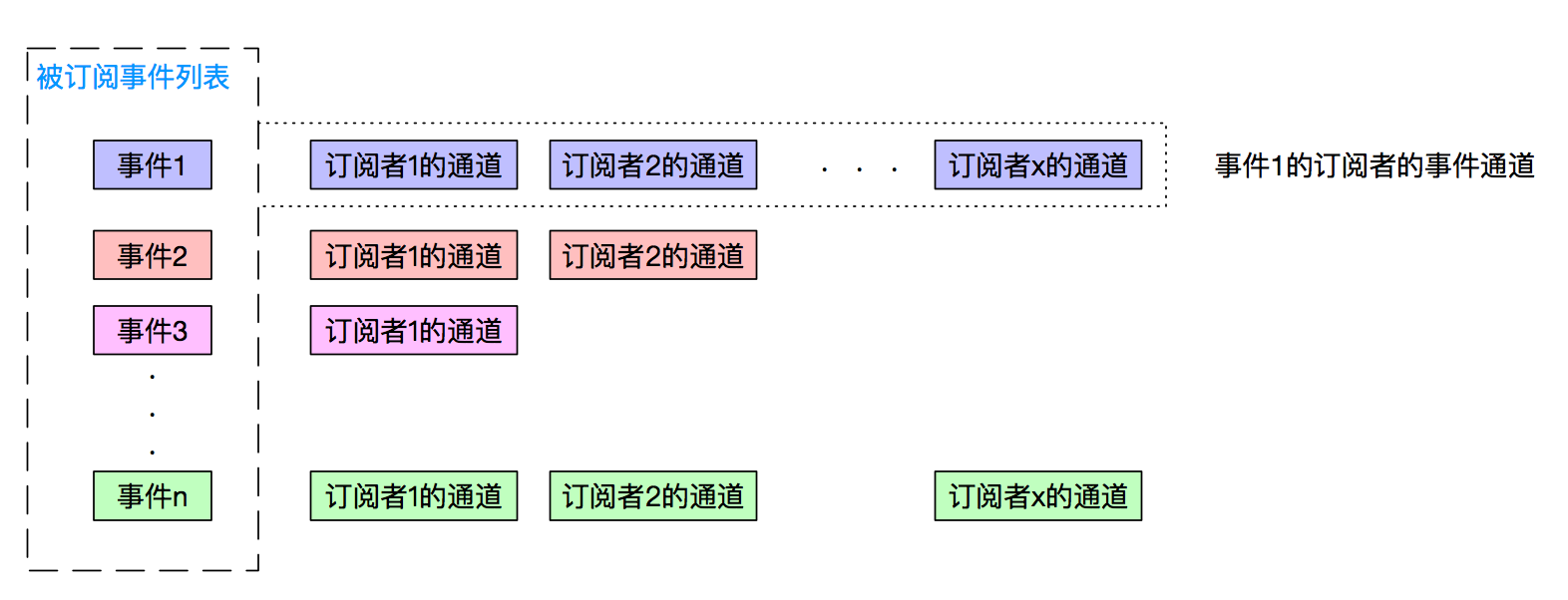过去在学Actor模型的时候,就认为异步消息是相当的重要,在华为的时候,也深扒了一下当时产品用的消息模型,简单实用,支撑起了很多模块和业务,但也有一个缺点是和其他的框架有耦合,最近看到以太坊的事件框架,同样简单简洁,理念很适合初步接触事件框架的同学,写文介绍一下。
以太坊的事件框架是一个单独的基础模块,存在于目录go-ethereum/event中,它有2中独立的事件框架实现,老点的叫TypeMux,已经基本弃用,新的叫Feed,当前正在广泛使用。
TypeMux和Feed还只是简单的事件框架,与Kafka、RocketMQ等消息系统相比,是非常的传统和简单,但是TypeMux和Feed的简单简洁,已经很好的支撑以太坊的上层模块,这是当下最好的选择。
TypeMux和Feed各有优劣,最优秀的共同特点是,他们只依赖于Golang原始的包,完全与以太坊的其他模块隔离开来,也就是说,你完全可以把这两个事件框架用在自己的项目中。
TypeMux的特点是,你把所有的订阅塞给它就好,事件来了它自会通知你,但有可能会阻塞,通知你不是那么及时,甚至过了一段挺长的时间。
Feed的特点是,它通常不存在阻塞的情况,会及时的把事件通知给你,但需要你为每类事件都建立一个Feed,然后不同的事件去不同的Feed上订阅和发送,这其实挺烦人的,如果你用错了Feed,会导致panic。
接下来,介绍下这种简单事件框架的抽象模型,然后再回归到以太坊,介绍下TypeMux和Feed。
事件框架的抽象结构

如上图,轻量级的事件框架会把所有的被订阅的事件收集起来,然后把每个订阅者组合成一个列表,当事件框架收到某个事件的时候,就把订阅该事件的所有订阅者找出来,然后把这个事件发给他们。
它需要具有2个功能:
- 让订阅者订阅、取消订阅某类事件。
- 让发布者能够发布某个事件,并且把事件送到每个订阅者。
如果做成完善的消息系统,就还得考虑这些特性:可用性、吞吐量、传输延迟、有序消息、消息存储、过滤、重发,这和事件框架相比就复杂上去了,我们专注的介绍下以太坊的事件模型怎么完成上述3个功能的。
以太坊的事件模型
TypeMux是一个以太坊不太满意的事件框架,所以以太坊就搞了Feed出来,它解决了TypeMux效率低下,延迟交付的问题。接下来就先看下这个TypeMux。
TypeMux:同步事件框架
TypeMux是一个同步事件框架。它的实现和上面讲的事件框架的抽象结构是完全一样的,它维护了一个订阅表,表里维护了每个事件的订阅者列表。它的特点:
- 采用多对多结构:多个事件对多个订阅者。
- 采用推模式,把事件/消息推送给订阅者,就像信件一样,会被送到你的信箱,你在信箱里取信就行了。
- 是一个同步事件框架。这也是它的缺点所在,举个例子就是:邮递员要给小红、小明送信,只有信箱里的信被小红取走后,邮递员才去给小明送信,如果小红旅游去了无法取信,邮递员就一直等在小红家,而小明一直收不到信,小明很无辜无辜啊!
看下它2个功能的实现:
- 订阅和取消订阅。订阅通过函数TypeMux.Subscribe(),入参为要订阅的事件类型,会返回TypeMuxSubscription给订阅者,订阅者可通过此控制订阅,通过TypeMuxSubscription.Unsubscribe() 可以取消订阅。
- 发布事件和传递事件。TypeMux.Post(),入参为事件类型,根据订阅表找出该事件的订阅者列表,遍历列表,依次向每个订阅者传递事件,如果前一个没有传递完成进入阻塞,会导致后边的订阅者不能及时收到事件。
TypeMux源码速递
TypeMux的精简组成:
// A TypeMux dispatches events to registered receivers. Receivers can be
// registered to handle events of certain type. Any operation
// called after mux is stopped will return ErrMuxClosed.
//
// The zero value is ready to use.
//
// Deprecated: use Feed
// 本质:哈希列表,每个事件的订阅者都存到对于的列表里
type TypeMux struct {
mutex sync.RWMutex // 锁
subm map[reflect.Type][]*TypeMuxSubscription // 订阅表:所有事件类型的所有订阅者
stopped bool
}订阅:
// Subscribe creates a subscription for events of the given types. The
// subscription's channel is closed when it is unsubscribed
// or the mux is closed.
// 订阅者只传入订阅的事件类型,然后TypeMux会返回给它一个订阅对象
func (mux *TypeMux) Subscribe(types ...interface{}) *TypeMuxSubscription {
sub := newsub(mux)
mux.mutex.Lock()
defer mux.mutex.Unlock()
if mux.stopped {
// set the status to closed so that calling Unsubscribe after this
// call will short circuit.
sub.closed = true
close(sub.postC)
} else {
if mux.subm == nil {
mux.subm = make(map[reflect.Type][]*TypeMuxSubscription)
}
for _, t := range types {
rtyp := reflect.TypeOf(t)
// 在同一次订阅中,不要重复订阅同一个类型的事件
oldsubs := mux.subm[rtyp]
if find(oldsubs, sub) != -1 {
panic(fmt.Sprintf("event: duplicate type %s in Subscribe", rtyp))
}
subs := make([]*TypeMuxSubscription, len(oldsubs)+1)
copy(subs, oldsubs)
subs[len(oldsubs)] = sub
mux.subm[rtyp] = subs
}
}
return sub
}取消订阅:
func (s *TypeMuxSubscription) Unsubscribe() {
s.mux.del(s)
s.closewait()
}发布事件和传递事件:
// Post sends an event to all receivers registered for the given type.
// It returns ErrMuxClosed if the mux has been stopped.
// 遍历map,找到所有订阅的人,向它们传递event,同一个event对象,非拷贝,运行在调用者goroutine
func (mux *TypeMux) Post(ev interface{}) error {
event := &TypeMuxEvent{
Time: time.Now(),
Data: ev,
}
rtyp := reflect.TypeOf(ev)
mux.mutex.RLock()
if mux.stopped {
mux.mutex.RUnlock()
return ErrMuxClosed
}
subs := mux.subm[rtyp]
mux.mutex.RUnlock()
for _, sub := range subs {
sub.deliver(event)
}
return nil
}
func (s *TypeMuxSubscription) deliver(event *TypeMuxEvent) {
// Short circuit delivery if stale event
// 不发送过早(老)的消息
if s.created.After(event.Time) {
return
}
// Otherwise deliver the event
s.postMu.RLock()
defer s.postMu.RUnlock()
select {
case s.postC <- event:
case <-s.closing:
}
}我上面指出了发送事件可能阻塞,阻塞在哪?关键就在下面这里:创建TypeMuxSubscription时,通道使用的是无缓存通道,读写是同步的,这里注定了TypeMux是一个同步事件框架,这是以太坊改用Feed的最大原因。
func newsub(mux *TypeMux) *TypeMuxSubscription {
c := make(chan *TypeMuxEvent) // 无缓冲通道,同步读写
return &TypeMuxSubscription{
mux: mux,
created: time.Now(),
readC: c,
postC: c,
closing: make(chan struct{}),
}
}Feed:流式框架
Feed是一个流式事件框架。上文强调了TypeMux是一个同步框架,也正是因为此以太坊丢弃了它,难道Feed就是一个异步框架?不一定是的,这取决于订阅者是否采用有缓存的通道,采用有缓存的通道,则Feed就是异步的,采用无缓存的通道,Feed就是同步的,把同步还是异步的选择交给使用者。
本节强调Feed的流式特点。事件本质是一个数据,连续不断的事件就组成了一个数据流,这些数据流不停的流向它的订阅者那里,并且不会阻塞在任何一个订阅者那里。
举几个不是十分恰当的例子。
- 公司要放中秋节,HR给所有同事都发了一封邮件,有些同事读了,有些同事没读,要到国庆节了HR又给所有同事发了一封邮件,这些邮件又进入到每个人的邮箱,不会因为任何一个人没有读邮件,导致剩下的同事收不到邮件。
- 你在朋友圈给朋友旅行的照片点了个赞,每当你们共同朋友点赞或者评论的时候,你都会收到提醒,无论你看没看这些提醒,这些提醒都会不断的发过来。
- 你微博关注了苍井空,苍井空发了个搞笑的视频,你刷微博的时候就收到了,但也有很多人根本没刷微博,你不会因为别人没有刷,你就收不到苍井空的动态。
Feed和TypeMux相同的是,它们都是推模式,不同的是Feed是异步的,如果有些订阅者阻塞了,没关系,它会继续向后面的订阅者发送事件/消息。
Feed是一个一对多的事件流框架。每个类型的事件都需要一个与之对应的Feed,订阅者通过这个Feed进行订阅事件,发布者通过这个Feed发布事件。
看下Feed是如何实现2个功能的:
- 订阅和取消订阅:Feed.Subscribe(),入参是一个通道,通常是有缓冲的,就算是无缓存也不会造成Feed阻塞,Feed会校验这个通道的类型和本Feed管理的事件类型是否一致,然后把通道保存下来,返回给订阅者一个Subscription,可以通过它取消订阅和读取通道错误。
- 发布事件和传递事件。Feed.Send()入参是一个事件,加锁确保本类型事件只有一个发送协程正在进行,然后校验事件类型是否匹配,Feed会尝试给每个订阅者发送事件,如果订阅者阻塞,Feed就继续尝试给下一个订阅者发送,直到给每个订阅者发送事件,返回发送该事件的数量。
Feed源码速递
Feed定义:
// Feed implements one-to-many subscriptions where the carrier of events is a channel.
// Values sent to a Feed are delivered to all subscribed channels simultaneously.
//
// Feeds can only be used with a single type. The type is determined by the first Send or
// Subscribe operation. Subsequent calls to these methods panic if the type does not
// match.
//
// The zero value is ready to use.
// 一对多的事件订阅管理:每个feed对象,当别人调用send的时候,会发送给所有订阅者
// 每种事件类型都有一个自己的feed,一个feed内订阅的是同一种类型的事件,得用某个事件的feed才能订阅该事件
type Feed struct {
once sync.Once // ensures that init only runs once
sendLock chan struct{} // sendLock has a one-element buffer and is empty when held.It protects sendCases. 这个锁确保了只有一个协程在使用go routine
removeSub chan interface{} // interrupts Send
sendCases caseList // the active set of select cases used by Send,订阅的channel列表,这些channel是活跃的
// The inbox holds newly subscribed channels until they are added to sendCases.
mu sync.Mutex
inbox caseList // 不活跃的在这里
etype reflect.Type
closed bool
}订阅事件:
// Subscribe adds a channel to the feed. Future sends will be delivered on the channel
// until the subscription is canceled. All channels added must have the same element type.
//
// The channel should have ample buffer space to avoid blocking other subscribers.
// Slow subscribers are not dropped.
// 订阅者传入接收事件的通道,feed将通道保存为case,然后返回给订阅者订阅对象
func (f *Feed) Subscribe(channel interface{}) Subscription {
f.once.Do(f.init)
// 通道和通道类型检查
chanval := reflect.ValueOf(channel)
chantyp := chanval.Type()
if chantyp.Kind() != reflect.Chan || chantyp.ChanDir()&reflect.SendDir == 0 {
panic(errBadChannel)
}
sub := &feedSub{feed: f, channel: chanval, err: make(chan error, 1)}
f.mu.Lock()
defer f.mu.Unlock()
if !f.typecheck(chantyp.Elem()) {
panic(feedTypeError{op: "Subscribe", got: chantyp, want: reflect.ChanOf(reflect.SendDir, f.etype)})
}
// 把通道保存到case
// Add the select case to the inbox.
// The next Send will add it to f.sendCases.
cas := reflect.SelectCase{Dir: reflect.SelectSend, Chan: chanval}
f.inbox = append(f.inbox, cas)
return sub
}发送和传递事件:这个发送是比较绕一点的,要想真正掌握其中的运行,最好写个小程序练习下。
// Send delivers to all subscribed channels simultaneously.
// It returns the number of subscribers that the value was sent to.
// 同时向所有的订阅者发送事件,返回订阅者的数量
func (f *Feed) Send(value interface{}) (nsent int) {
rvalue := reflect.ValueOf(value)
f.once.Do(f.init)
<-f.sendLock // 获取发送锁
// Add new cases from the inbox after taking the send lock.
// 从inbox加入到sendCases,不能订阅的时候直接加入到sendCases,因为可能其他协程在调用发送
f.mu.Lock()
f.sendCases = append(f.sendCases, f.inbox...)
f.inbox = nil
// 类型检查:如果该feed不是要发送的值的类型,释放锁,并且执行panic
if !f.typecheck(rvalue.Type()) {
f.sendLock <- struct{}{}
panic(feedTypeError{op: "Send", got: rvalue.Type(), want: f.etype})
}
f.mu.Unlock()
// Set the sent value on all channels.
// 把发送的值关联到每个case/channel,每一个事件都有一个feed,所以这里全是同一个事件的
for i := firstSubSendCase; i < len(f.sendCases); i++ {
f.sendCases[i].Send = rvalue
}
// Send until all channels except removeSub have been chosen. 'cases' tracks a prefix
// of sendCases. When a send succeeds, the corresponding case moves to the end of
// 'cases' and it shrinks by one element.
// 所有case仍然保留在sendCases,只是用过的会移动到最后面
cases := f.sendCases
for {
// Fast path: try sending without blocking before adding to the select set.
// This should usually succeed if subscribers are fast enough and have free
// buffer space.
// 使用非阻塞式发送,如果不能发送就及时返回
for i := firstSubSendCase; i < len(cases); i++ {
// 如果发送成功,把这个case移动到末尾,所以i这个位置就是没处理过的,然后大小减1
if cases[i].Chan.TrySend(rvalue) {
nsent++
cases = cases.deactivate(i)
i--
}
}
// 如果这个地方成立,代表所有订阅者都不阻塞,都发送完了
if len(cases) == firstSubSendCase {
break
}
// Select on all the receivers, waiting for them to unblock.
// 返回一个可用的,直到不阻塞。
chosen, recv, _ := reflect.Select(cases)
if chosen == 0 /* <-f.removeSub */ {
// 这个接收方要删除了,删除并缩小sendCases
index := f.sendCases.find(recv.Interface())
f.sendCases = f.sendCases.delete(index)
if index >= 0 && index < len(cases) {
// Shrink 'cases' too because the removed case was still active.
cases = f.sendCases[:len(cases)-1]
}
} else {
// reflect已经确保数据已经发送,无需再尝试发送
cases = cases.deactivate(chosen)
nsent++
}
}
// 把sendCases中的send都标记为空
// Forget about the sent value and hand off the send lock.
for i := firstSubSendCase; i < len(f.sendCases); i++ {
f.sendCases[i].Send = reflect.Value{}
}
f.sendLock <- struct{}{}
return nsent
}转载自:https://lessisbetter.site/2018/10/18/ethereum-code-event-framework/
版权属于:区块链中文技术社区 / 转载原创者
本文链接:https://www.bcskill.com/index.php/archives/1162.html
相关技术文章仅限于相关区块链底层技术研究,禁止用于非法用途,后果自负!本站严格遵守一切相关法律政策!
楼主残忍的关闭了评论